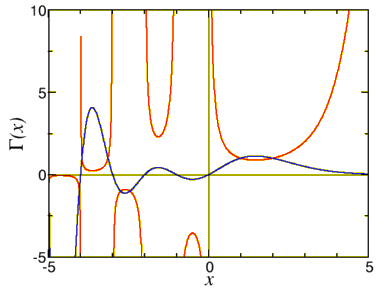10.3: Gamma Function
( \newcommand{\kernel}{\mathrm{null}\,}\)
For ν not an integer the recursion relation for the Bessel function generates something very similar to factorials. These quantities are most easily expressed in something called a Gamma-function, defined as
Γ(ν)=∫∞0e−ttν−1dt,ν>0.
Some special properties of Γ function now follow immediately:
Γ(1)=∫∞0e−tdt=−e−1|∞0=1−e−∞=1Γ(ν)=∫∞0e−ttν−1dt=−∫∞0de−tdttν−1dt=−e−ttν−1|∞0+(ν−1)∫∞0e−ttν−2dt
The first term is zero, and we obtain Γ(ν)=(ν−1)Γ(ν−1)
From this we conclude that
Γ(2)=1⋅1=1,Γ(3)=2⋅1⋅1=2,Γ(4)=3⋅2⋅1⋅1=2,Γ(n)=(n−1)!.
Thus for integer argument the Γ function is nothing but a factorial, but it also defined for other arguments. This is the sense in which Γ generalises the factorial to non-integer arguments. One should realize that once one knows the Γ function between the values of its argument of, say, 1 and 2, one can evaluate any value of the Γ function through recursion. Given that Γ(1.65)=0.9001168163 we find
Γ(3.65)=2.65×1.65×0.9001168163=3.935760779.
Evaluate Γ(3), Γ(11), Γ(2.65).
- Answer
-
2!=2, 10!=3628800, 1.65×0.9001168163=1.485192746.
We also would like to determine the Γ function for ν<1. One can invert the recursion relation to read Γ(ν−1)=Γ(ν)ν−1, Γ(0.7)=Γ(1.7)/0.7=0.909/0.7=1.30.
What is Γ(ν) for ν<0? Let us repeat the recursion derived above and find Γ(−1.3)=Γ(−0.3)−1.3=Γ(0.7)−1.3×−0.3=Γ(1.7)0.7×−0.3×−1.3=3.33. This works for any value of the argument that is not an integer. If the argument is integer we get into problems. Look at Γ(0). For small positive ϵ Γ(±ϵ)=Γ(1±ϵ)±ϵ=±1ϵ→±∞. Thus Γ(n) is not defined for n≤0. This can be easily seen in the graph of the Γ function, Fig. 10.3.1.

Figure 10.3.1: A graph of the Γ function (solid line). The inverse 1/Γ is also included (dashed line). Note that this last function is not discontinuous.
Finally, in physical problems one often uses Γ(1/2), Γ(12)=∫∞0e−tt−1/2dt=2∫∞0e−tdt1/2=2∫∞0e−x2dx. This can be evaluated by a very smart trick, we first evaluate Γ(1/2)2 using polar coordinates Γ(12)2=4∫∞0e−x2dx∫∞0e−y2dy=4∫∞0∫π/20e−ρ2ρdρdϕ=π. (See the discussion of polar coordinates in Sec. 7.1.) We thus find Γ(1/2)=√π,Γ(3/2)=12√π,etc.


